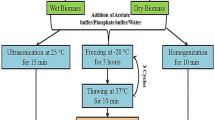Abstract
2-Aminoindan-2-phosphonic acid (AIP), a specific competitive phenylalanine ammonia lyase (PAL) inhibitor was applied to a suspension cell culture of Cistanche deserticola. The effects of AIP treatment on cell growth, PAL activity, contents and yields of total phenolic compound, salidroside and four phenylethanoid glycosides (PheGs) are investigated. The results demonstrated that, 0.5 and 2.0 μM AIP treatments had similar effects on the measurements investigated in this study. AIP treatment resulted in significant decreases in PAL activity, total phenolic compounds content, and PheGs content. Linear regression analysis showed that PAL activity had a high correlation coefficient with the total phenolic compound content and the four PheGs contents. Total PAL activity-time area under curve (AUC) had a high correlation coefficient with the total phenolic compound yield and the yields of five tested compounds in untreated cell samples. In AIP-treated cells, total PAL activity-time AUC retained a high correlation with the total phenolic compound yield and the yields of three tested compounds, echinacoside, acteoside, and tubuloside A, but not salidroside and cistanoside A. The difference could be caused by the different biosynthetic origins of each of the tested compounds. These results demonstrate the important role of PAL in the biosynthesis of PheGs in the suspension cell culture of C. deserticola.








Similar content being viewed by others
References
Chapple CCS, Walker MA, Ellis BE (1986) Plant tyrosine decarboxylase can be strongly inhibited by l-α-aminooxy-β-phenylpropionate. Planta 167:101–105
Cheng XY, Guo B, Zhou HY et al (2005) Repeated elicitation enhances phenylethanoid glycosides accumulation in suspension cell cultures of Cistanche deserticola. J Biochem Eng 24:203–207
Cheng XY, Zhou HY, Cui X et al (2006) Improvement of phenylethanoid glycosides biosynthesis in Cistanche deserticola suspension cell cultures by chitosan elicitor. J Biotechnol 121(2):253–260
Ellis BE (1983) Production of hydroxyphenylethanol glycosides in suspension cultures of Syringa vulgaris. Phytochemistry 22(9):1941–1943
Gamborg OL, Miller RA, Ojima K (1968) Nutrient requirements of suspension cultures of soybean root cells. Exp Cell Res 50:151–158
Geng XC, Song LW, Pu XP et al (2004) Neuroprotective Effects of Phenylethanoid Glycosides from Cistanches salsa against 1-Methyl-4-phenyl-1,2,3,6-tetrahydro-pyridine (MPTP)-Induced Dopaminergic Toxicity in C57 Mice. Biol Pharm Bull 27(6):797–801
Hu GS (2007) Studies on the suspension cell culture and molecular biology of Cistanche deserticola. Master degree thesis, Shenyang Pharmaceutical University
Hu GS, Jia JM, Hur YJ et al (2010) Molecular characterization of phenylalanine ammonia lyase from Cistanche deserticola. Mol Bio Rep. doi:10.1007/s11033-010-0489-0
Karasawa H, Kobayashi H, Takizawa N et al (1986) Studies on the constituents of Cistanchis Herba. VIII. Yakugaku Zasshi 106(8):721–724
Kobayashi H, Karasawa H, Miyase T et al (1984a) Studies on the constituents of Cistanchis Herba. IV. Chem Pharm Bull 32(10):3880–3885
Kobayashi H, Karasawa H, Miyase T et al (1984b) Studies on the constituents of Cistanchis Herba. III. Chem Pharm Bull 32(8):3009–3014
Kobayashi H, Karasawa H, Miyase T et al (1985) Studies on the constituents of Cistanchis Herba. V. Chem Pharm Bull 33(4):1452–1457
Kobayashi H, Karasawa H, Takizawa N et al (1986) Studies on the constituents of Cistanchis Herba. VII. Yakugaku Zasshi 106(7):562–566
Liu CZ, Cheng XY (2008) Enhancement of phenylethanoid glycosides biosynthesis in cell cultures of Cistanche deserticola by osmotic stress. Plant Cell Rep 27:357–362
Liu JY, Guo ZG, Zeng ZL (2007) Improved accumulation of phenylethanoid glycosides by precursor feeding to suspension culture of Cistanche salsa. Biochem Eng J 33:88–93
Lu CT, Mei XG (2003) Improvement of phenylethanoid glycosides production by a fungal elicitor in suspension cell culture of Cistanche deserticola. Biotechnol Lett 25:1437–1439
Ouyang J, Wang XD, Zhao B et al (2003a) Light intensity and spectral quality influencing the callus growth of Cistanche deserticola and biosynthesis of phenylethanoid glycosides. Plant Sci 165:657–661
Ouyang J, Wang XD, Zhao B et al (2003b) Effects of rare earth elements on the growth of Cistanche deserticola cells and the production of phenylethanoid glycosides. J Biotechnol 102:129–134
Ouyang J, Wang XD, Zhao B et al (2005) Enhanced production of phenylethanoid glycosides by precursor feeding to cell culture of Cistanche deserticola. Process Biochem 40:3480–3484
Pu XP, Song ZH, Li YY et al (2003) Acteoside from Cistanche salsa inhibits apoptosis by 1, 2-methyl phenylpyridinium ion in cerebellar granule neurons. Planta Med 69:652–666
Saimaru H, Orihara Y (2010) Biosynthesis of acteoside in cultured cells of Olea europaea. J Nat Med 64:139–145
Sheng GQ, Pu XP, Lei L et al (2002) Tubuloside B from Cistanche salsa rescue the PC12 neuronal cells from methylphenylpyridinium ion induced apoptosis and oxidatives stress. Planta Med 68:966–970
Singleton VL, Orthofer R, Lamuela-Raventós RM (1999) Analysis of total phenols and other oxidation substrates and antioxidants by means of Folin-Ciocalteu reagent. Method Enzymol 299:152–178
Tian XF, Pu XP (2005) Phenylethanoid glycosides from Cistanches salsa inhibit apoptosis induced by 1-methyl-4-phenylpyridinium ion in neurons. J Ethnopharmacol 97:59–63
Xiong Q, Kadota S, Tani T et al (1996) Antioxidative effects of phenylethanoids from Cistanche deserticola. Biol Pharm Bull 19(12):1580–1585
Acknowledgments
This work was supported by the Dong-A University research fund. We would like to thank Professor Jerry Zon who works at the Institute of Organic Chemistry Biochemistry and Biotechnology, Wrocław University of Technology in Poland for providing us AIP. We also would like to show our appreciation to Dr. Nobuhisa Ezaki at the Yomeishu Seizo Company in Japan for giving us standard compounds cistanoside A, acteoside and tubuloside A for our experiments.
Author information
Authors and Affiliations
Corresponding author
Additional information
Communicated by Q. Zhao.
Electronic supplementary material
Below is the link to the electronic supplementary material.
Rights and permissions
About this article
Cite this article
Hu, G.S., Hur, Y.J., Jia, J.M. et al. Effects of 2-aminoindan-2-phosphonic acid treatment on the accumulation of salidroside and four phenylethanoid glycosides in suspension cell culture of Cistanche deserticola . Plant Cell Rep 30, 665–674 (2011). https://doi.org/10.1007/s00299-010-0997-3
Received:
Revised:
Accepted:
Published:
Issue Date:
DOI: https://doi.org/10.1007/s00299-010-0997-3




